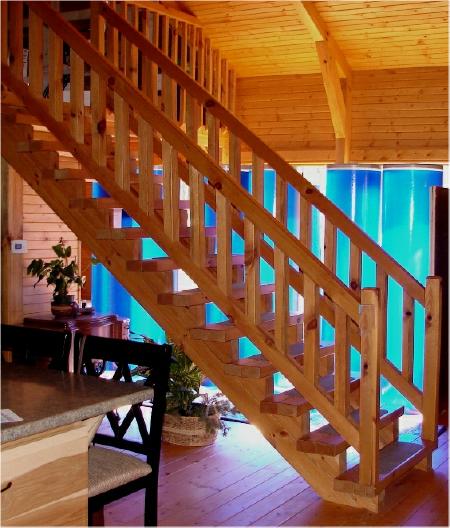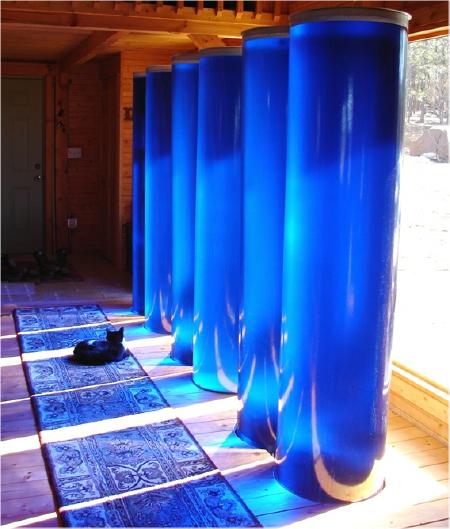7 - Fiberglass water tube Trombe wall heating & cooling
We no longer sell fiberglass heat storage tubes or color dyes and we cannot offer any shopping referrals. There was nothing wrong with the passive solar water tubes we sold or the manufacturer. Motor freight shipping just became much too risky and shockingly expensive. Plastic and metal barrels are locally available, often free, and relatively easy to stack for retaining vast amounts of energy in a perfectly functional Trombe wall. The primary reason to choose fiberglass tubes is for their aesthetic appeal. Rather than searching online for ready-made tubes and paying more for freight delivery than you do for the tubes, we suggest having tubes made to order by a local fiberglass molding firm. The rapid growth of the aquaculture industry has greatly opened up that market in recent years.
Friction fit caps were common practice for our heat storage tubes to stop evaporation and prevent water contamination. Fiberglass can be trimmed with an angle grinder abrasive wheel or by hand with a pair of tin snips to adjust height. Commonly available fiberglass resin is used for repairs and reapplication to exterior when the surface coating starts to wear off in direct sunlight. To eliminate unwanted algae growth in passive solar heat storage tube water, add copper sulfate at the rate recommended by the manufacturer (about 1 gram per 250 gallons). Note copper sulfate is a corrosive chemical, harmful to metal and hazardous to humans and toxic to fish in its concentrated form, so at least wear eye protection. Avoid using bleach in heat storage tubes since chlorine will dissolve any color dyes you may have in the water.
We no longer sell water soluble dyes to increase solar gain in tubes and do not have a reliable referral. Pylam brand (or similar) powdered triphenylmethane (or similar) water-soluble dye is traditionally used. Avoid introducing dye powder directly to the tube. Mix a couple of tablespoons of powdered dye with a cup of water first and then add to the surface of a full tube. Rit brand all-purpose liquid dye will work for a limited number of tubes and allow you to custom color by mixing dyes. Allow dye to disperse slowly for an hour before adding more to get the tint you want. Darkest Black is best for solar absorption. Medium-dark colors allow for some light transmission, as pictured below. Green and blue can improve the mood.


Full heat storage water tubes, especially those with an 18 inch diameter base, are heavy enough that gravity keeps them from being tipsy, but safety first. Not shown in these images is the need to build a framework of stainless steel cable and copper or galvanized pipe with strapping and binding anchors around the top of tubes to prevent an unfortunate accident. Engineers recommend avoiding the use of solely wood framework to enclose tubes at this weight. And be sure to add additional flooring support underneath to carry the heavy load.
Fiberglass heat storage tubes excel at passive solar home and sunroom conservatory heating and cooling by eliminating daily temperature swings. Thermal mass in a water filled Trombe wall is classic passive solar low-tech with no moving parts or electricity needed. By day, water storage tubes prevent wide temperature swings with absorbing and diffusing overwhelming amounts of direct solar energy. By night, tubes release stored energy to moderate temperatures and help keep the attached greenhouse or solarium deck from getting too cold. Non-electric sunroom radiant cooling during the day and sunroom radiant heating at night. Noticeable effective range, where your skin will feel the radiant temperature difference, is about ten feet for very gentle, silent non-electric heating and cooling that is best for plants and people alike.
Tubes are best placed in direct sunlight, but will perform a subtle radiant effect in the shade. Key to choosing how many tubes is knowing the average Btu of excess solar energy your glazing is generating. In practice, the more tubes the better, especially when room temperatures are fluctuating wildly. Fiberglass heat storage water tubes can only absorb as much energy as is directly presented to them. Placed in the shade, they will absorb some of the ambient room temperature differential, but the majority of heat gain is direct passive solar energy collection from being placed in direct sunlight. Generally, fiberglass water tubes should be constructed of at least 23 percent glass reinforcement by weight with no use of fillers or resin extenders. Solar transmission should average at least 80% with a minimum wall thickness of .040 inches for 12 inch tubes and .060 inches for 18 inch diameter. Tube stock should meet or exceed U.S. Commercial Standard P.S. 53-72.
Tube Size | Volume | Weight | Heat Capacity | Floor Loading |
|---|---|---|---|---|
12 inch x 4 foot | 23.5 gallon | 204 pound | 3,900 Btu | 260 pounds |
12 inch x 8 ft | 47 gallon | 404 pound | 7,800 Btu | 514 pounds |
18 inch x 5 ft | 66 gallon | 566 pound | 11,000 Btu | 321 pounds |
18 inch x 10 ft | 132 gallon | 1122 pound | 22,000 Btu | 635 pounds |
HTM Passive Solar eBook – Table of Contents
- introduction to high thermal mass pragmatic design, low-tech functions, and materials
- photo gallery is packed with images, commentary, and our free HTM Home Tour video
- dry stack surface bonding cement construction photos and some block layout sketches
- floor plans features several functional basic layouts and commentary on design choice
- roof detail chapter with T&G plank-style vented roof decking atop log purlin joist beams
- sun screens critical passive solar design component to create favorable micro-climates
- heat storage fiberglass water tanks are a low-tech way to moderate temperature swings
- earth tubing is simple passive technique to temper a household’s fresh air return intake
- solar orientation isn’t critical since HTM designs excel in hot or cold climates anywhere
- exterior fascia SBC coatings over EPS foam board insulation and sloped glazing details
- wing insulation and shallow footer, frost-protected perimeter foundation design choices
- planter beds are a central, functional component of greenhouse-style HTM construction
- links page is filled with a helpful selection of research references and relevant websites

